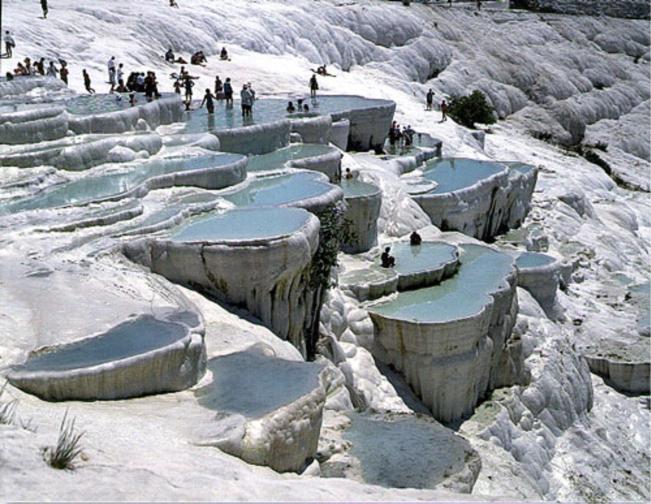Thousands of years ago, the Romans built the city of Hierapolis so their citizens can enjoy the health benefits of a hot mineral water. Flash forward to 2015, and the city of Pamukkale in Turkey is still one of the healthiest and most mysterious places in the world. Deep in the earth beneath the city lies a vast source of water that is heated by volcanic lava. As a result, the water dissolves pure white calcium, and then becomes saturated with the calcium before appearing on the surface of the earth where it bursts and runs down a steep hillside. As the calcium cools in the open air, the material precipitates from the water and adheres the soil. And the end result is a form of calcium cascades frozen in stone.
The Legend of Pamukkale
As every mysterious place in the world, Pamukkale has a strong legend that makes the place even more appealing. People believe that back in the days, there was a Turkish young girl that no one wanted to marry because she was ugly. Depressed, the girl tried to commit suicide throwing herself off the travertine. She fell into a natural pool and survived the fall. The water in the pool turned her into a beautiful girl who caught the attention of the Turkish lord Denizli while he was passing by the place. He fell in love with the girl and decided to marry her. That is why people nowadays believe that in addition to the health benefits, the rocks in Pamukkale can make you more beautiful.
Understanding the mystery of Pamukkale
In order to explain the mystery of Pamukkale, we must explain the geology of the spot. The terraces of the place are made out of travertine, a sedimentary rock that is deposited by water.
There are 17 hot springs in Pamukkale with temperature ranging from 35 degrees to 100 degrees. The water, once emerging from the spring, is then transported 320m to the head of thee terraces where it deposits calcium carbonate. Once the water reaches the surface, carbon dioxide is de-gassed and the result is deposition of calcium carbonate. The deposition continues until the carbon dioxide in the water and in the air is balanced. Calcium carbonate is deposited as a soft jelly, but in the travertine the carbonate hardens.
Health Benefits
Pamukkale is considered a natural health spa thanks to the many benefits it provide for its visitors. According to many, the water provides cure against asthma and rheumatism.
Additionally, the water brings benefits to the skin, eyes, helps recover from high blood pressure, kidney stones, stroke, physical exhaustion, circulatory issues, digestive maladies, chronic disorders and nutritional disorders.
Best time to visit Pamukkale is the spring, as the weather and the climate is at a normal level. In the summer, the temperature can go up to 40+ degrees and humidity is another issue.
Tourist destination
Up until the 1980s, Pamukkale was a local destination in Turkey, and not many people outside of the country knew the benefits of the water. But then the local authorities decided to market and develop Pamukkale as a spa center. Motels were razed and the land became clear, the road up the slope was converted into pools, and visitors were allowed in them to walk, play, splash and even soak.
But most importantly, the pools are designed for swimmers who like to experience the health and beauty benefits of the hot water.
In 1988, Pamukkale was made a World Heritage Site. To protect the site, access to terraces is limited and visitors must follow the main pathway. Small pools are the only ones allowed for swimming and bathing in order to protect the thermal waters.



